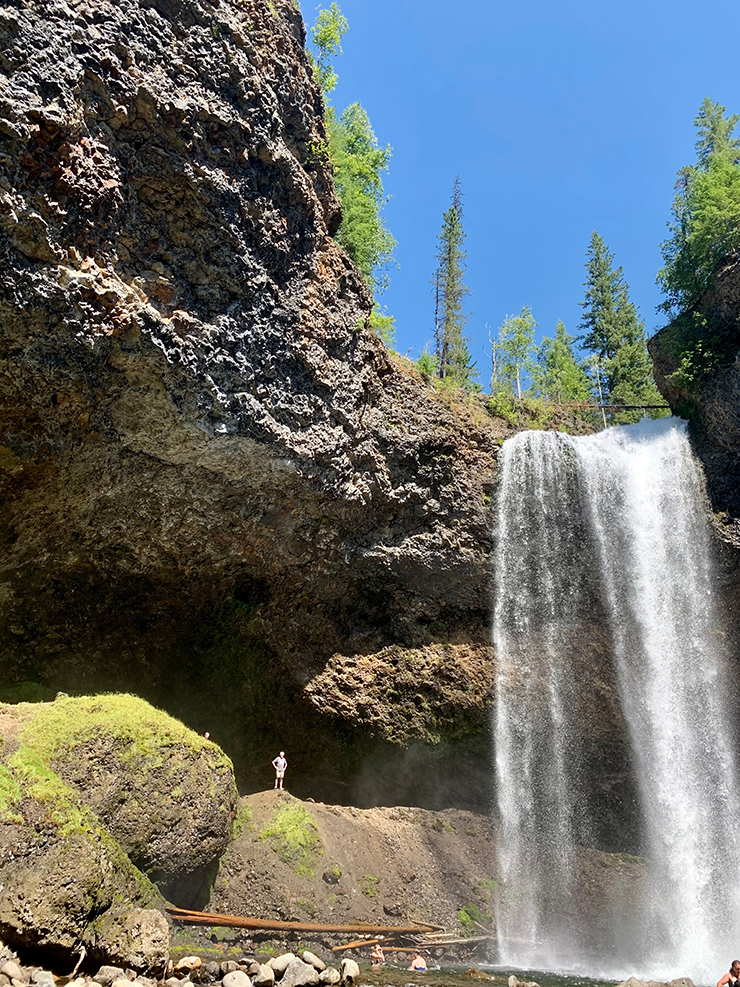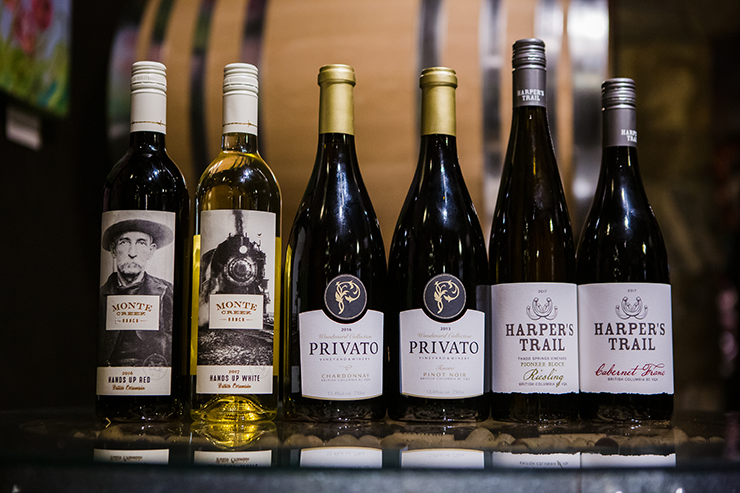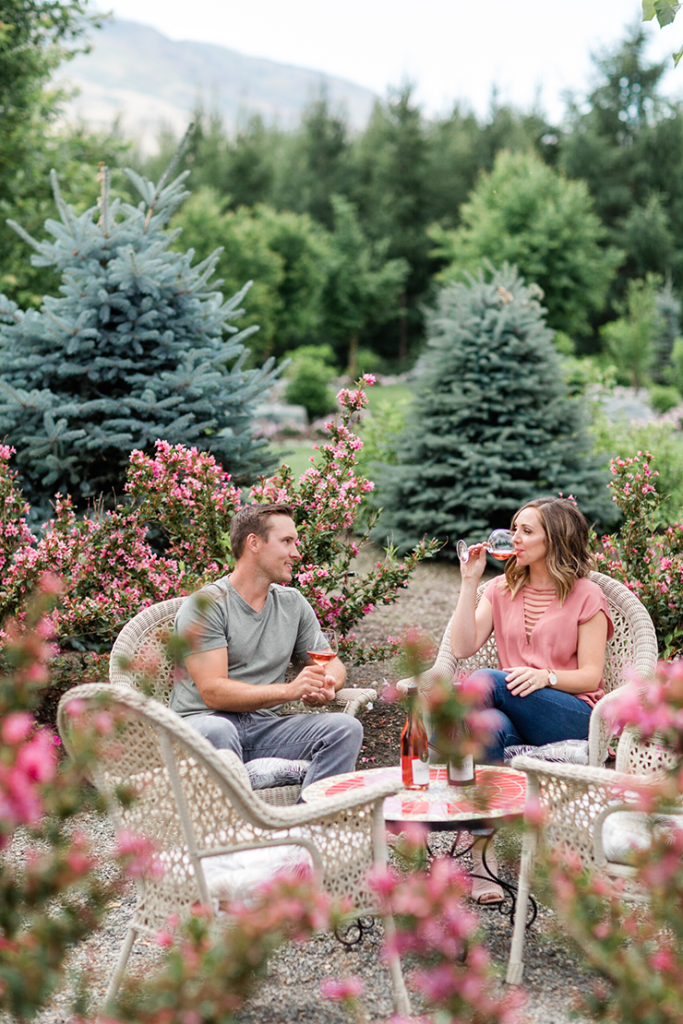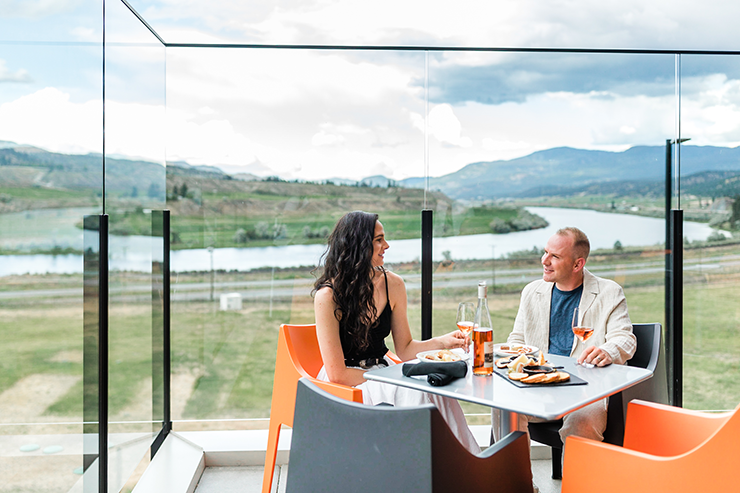Exploring Kamloops and Wells Gray Park
Words Susan Lundy

Zooming in a powerful boat though the turquoise, glacier-fed water of Clearwater Lake, we’re on the hunt: we’re seeking out some of the area’s magnificent lake-edge waterfalls and, at the same time, discovering the glories of Wells Gray Park.
It’s the second time on this trip to BC’s southern interior that we’ve been on the hunt. Just a few days ago, in Kamloops, we sought out the best of the area’s burgeoning wine industry.
Our four-day getaway to these neighbouring areas, located about 90 minutes apart, afforded the best of two worlds: the explosive wilderness of Wells Gray Park and small-town vibe of nearby Clearwater, combined with the more urban, but still laid-back city of Kamloops.
Each presented its share of surprises and hidden gems—as well a hunt for the best of water and wine.
Water
At 524,990 hectares or 1.3 million acres, and covering 5,250 square kilometres, Wells Gray is among the largest parks in the province and offers some of the most spectacular untouched scenery in the world. It also has 41 named waterfalls, with dozens of others scattered throughout the wilderness.
So, to be clear, this is not any old “water.” The falls at Wells Gray are truly magnificent, and by the time we boarded the boat for a tour of Clearwater Lake, we’d already explored two of the area’s most famous falls: Helmcken and Moul.
At Helmcken Falls, the water cascades in a breathtaking 141-metre drop, sending a thundering sound across the canyon to the viewing platforms. These falls—probably the most spectacular in the whole park—are easily accessed via viewing areas located just a short stroll from the parking lot.
We also took a one-hour hike down a mossy forest trail to Moul Falls, which can be viewed from above or right down at the base of the chute where the falls spill into Clearwater River. Here, you can walk along a narrow ledge on the side of the canyon and slip behind the veil of the waterfall, experiencing the cool mist of the rushing waters.
Our hike to Moul Falls was augmented by the commentary of Gy Ovenden, who along with his wife, Joanne, owns Discover Wells Gray. Gy’s commentary and insight about the park, the nearby town of Clearwater and the flora and fauna of the forest itself made the hike fascinating as well as fun. As a former wildlife and nature conservation advisor and an experienced ecologist, Gy is extremely informed.
To get to our waterfall-hunting boat tour, we drove 68 kilometres to the end of a bumpy, gravel road and arrived at a campground and cafe, and the office and dock of Clearwater Lake Tours. The tour company, which has been in business here for over 30 years, offers a number of services, including canoe, kayak, fishing, interpretive guided tours and camping gear rentals. It also provides water taxi service to any of the 11 water-access-only, lake-side campgrounds. (However, most people prefer to kayak or canoe to these remote spots.)
Our time on the lake with our super friendly and informed guide gave us another way to view this pristine park, offering glimpses of the area’s alpine meadows and remote hiking potential and a chance to learn about the natural forces that produced Wells Gray’s volcanoes, waterfalls, mineral springs and glaciers.
As it turns out, it’s not all about the water—but we did discover some impressive falls along the way.
Wine

There were many things to love about our two days in Kamloops, and we only scratched the surface of the city, choosing to explore the area as a wine destination. To be sure, there are many other ways to dig into Kamloops, which is flush with biking trails, golf courses, local shops and boutiques, and a rich Indigenous culture.
But then there’s the wine. Nestled amid the North and South Thompson rivers, and named as one of BC’s official wine regions in 2018, the Thompson Valley’s well-drained soils are rich in mineral content—perfect for grape-growing. The result is bright, crisp and aromatic whites, and fruit-forward reds. The flavours are unique to this region and it’s easy to taste the difference between wines here and those in the nearby and more recognizable Okanagan wine region.
At Monte Creek Winery, we sat at a picnic table in a lush, grassy setting with rows of vines climbing the hill at our backs and a forward-facing view of the South Thompson River weaving through the valley. To this beautiful backdrop, we tasted a wealth of wines, from a crisp, sparkling rose to a creamy white and the winery’s signature blueberry wine. The reds are delicious, but it’s the whites that truly show off the region’s flavours.
Harper’s Trail, located right on the banks of the South Thompson, was the area’s first winery, established in 2012. Seated on the patio, with hoodoos and rolling hills of sage and antelope brush behind us, we savoured an excellent selection of wine, and we couldn’t resist purchasing bottles of the sparkling Chardonnay and pinot noir to add to our collection from Monte Creek.

More purchases occurred the next day, after sampling the vintages at Privato Vineyard & Winery, which offered a to-die-for selection of pinot noir and premium-quality, single-vineyard Burgundy wines. This boutique winery, which crafts wine in small batches and distributes to a small selection of restaurants and wine aficionados, is set on an eight-acre Christmas tree farm. The patio—where we enjoyed a generously portioned charcuterie plate—is set amid a garden full of flowers.
The fourth and final winery in the Thompson Valley wine region is Sagewood, a family owned and operated boutique vineyard. While we ran out of time to visit Sagewood on this tour, it’s high on our to-do list for when we return—and continue the hunt.

do.
Take a guided hike with Discover Wells Gray: among the tour company’s offerings is a half-day Forest, Falls and Flowers Tour, where hikers can discover the wildflowers, birds and other wildlife of the forests, and witness the geologic and human history that shaped Wells Gray. Or, take an Electric Duffy Boat Tour with Clearwater Lake Tours, exploring Clearwater and Azure lakes, which are linked by a river, perhaps stopping to swim in the refreshing (cold!) water. Both companies offer a variety of tours; check their websites for more info.

see.
Explore Dutch Lake and find a painted turtle! From our accommodation at Dutch Lake Resort in Clearwater, we swam in the lake and rented a canoe for a sunset paddle—all the while keeping an eye out for the brightly-hued turtles that are frequently found sunning themselves on logs. Dutch Lake is spring-fed, which makes it warm for swimming. It’s also stocked annually by the local trout hatchery with rainbow and brook trout.

stay.
As we were traveling with our dog, pet-friendly accommodation was essential—and we lucked out, both in Kamloops and Clearwater. Our stay at the Delta Hotel Kamloops provided a central location with easy access to restaurants and a must-do riverside walkway (including a great off-leash dog beach).Our room was spacious and comfortable room; and be sure to check out the hotel’s rooftop pool and hot tub with food and beverage service. At the Dutch Lake Resort in Clearwater, we tucked into an A-frame cabin on the water’s edge, enjoying numerous amenities in an excellent location near the entrance to Wells Gray Park. Book ahead for the resort’s popular Painted Turtle restaurant.

eat/drink.
In Clearwater, plan for breakfast at Wild Flour Café. Everything is made from scratch, using the bakery’s own fresh-milled ancient grain flours, and it proudly supports the area’s local and organic food producers. We also ate several meals on the outdoor patio at Gateway Grill, where the food was delicious and the service impeccable. In Kamloops, we feasted at Monte Creek Winery, which, in addition to its excellent vintages, features seasonal al fresco patio dining at The Terrace Restaurant or at the (pet-friendly) picnic tables where we sat.The menu is extensive and we savoured the cuisine alongside a selection of wine samples.

 Alchemy of sleep
Alchemy of sleep